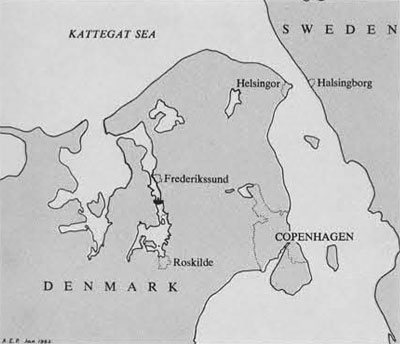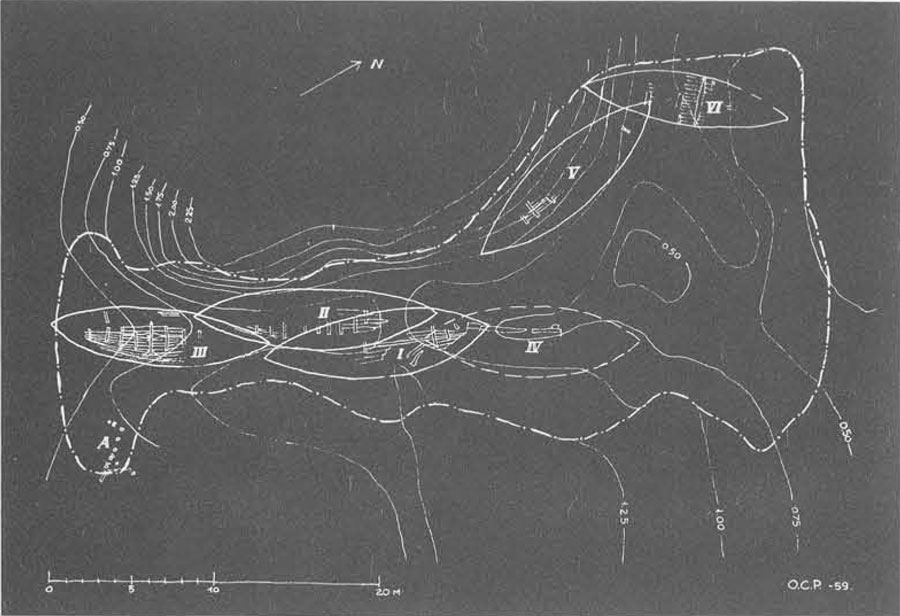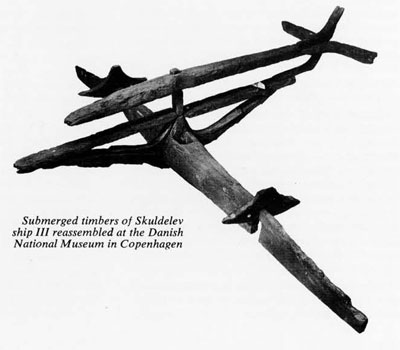
As Scandinavian life is closely related to the surrounding seas, it is natural for museum explorers in these northern countries to search offshore for traces of the past.
Sweden has already triumphed in this area of endeavor, locating the mighty warship Vasa at the bottom of Stockholm harbor. The Vasa, which ran into a squall and sank on its maiden voyage in 1628, was rediscovered in 1956 at a depth of 100 feet, and finally brought to the surface last April.
 The Royal Swedish Navy and the Maritime Museum of Stockholm cooperated in this venture. Six tunnels were dug under the hull, through which steel wires were passed, creating a “hammock-type” hoisting mechanism. The 165-foot hull was finally raised, and the man o’war, in eighteen stages, was towed to shallow water. Cannon and many pieces of wood sculpture were raised with the Vasa. Once the pride of the Swedish fleet, the Vasa was a daily tourist attraction last summer at its mooring in the harbor. It is the oldest identifiable ship in the world.
The Royal Swedish Navy and the Maritime Museum of Stockholm cooperated in this venture. Six tunnels were dug under the hull, through which steel wires were passed, creating a “hammock-type” hoisting mechanism. The 165-foot hull was finally raised, and the man o’war, in eighteen stages, was towed to shallow water. Cannon and many pieces of wood sculpture were raised with the Vasa. Once the pride of the Swedish fleet, the Vasa was a daily tourist attraction last summer at its mooring in the harbor. It is the oldest identifiable ship in the world.
Now, officials of the National Museum in Denmark are fishing for prizes which may outweigh the Vasa, in historical significance at least. For many years Danish fishermen reported a sunken ship blocking a narrow channel in the fjord leading southward from the Kattegat sea to Roskilde, a small town famous for its cathedral, twenty miles west of Copenhagen. “Queen Margrethe’s Ship,” according to local tradition, had been sunk between two small islands in the channel by order of the Scandinavian queen (1387- 1412), to protect Roskilde from pirate raids.
But salvaged fragments indicated that the wreck dated from earlier times–from the Viking period.
Lured by these fragments, staff members at the National Museum, headed by Olaf Olsen, took some lessons in frogmanship, and in the summer of 1957, embarked on the underwater excavation project. The work of three summers confirmed that the wreck is of Viking origin, from the 9th, 10th, or 11th century. Moreover, divers found not one, but at least six small ships filled with rocks. Some of the vessels lay on top of each other, some in a row.
The project has now been stalled over the last two summers while the museum awaits funds to proceed with the next step–draining this area of the channel arter surrounding it with steel pilings, and delicately raising the ships. Mr. Olsen estimates that one hundred thousand dollars will be needed to complete the resurrection, which should get underway this year (1962). The work has been financed until now by private funds and the museum’s budget, while a number of firms have contributed the necessary diving and working equipment.
It is hoped that one or two of the vessels may be raised intact. Their wooden pins are no longer secure and the wood surface is softened, but the oak frames and planking are for the most part well preserved. Unfortunately, one of the ships has been broken apart by fishermen cracking through the blockage over the years. The Danes plan to consult with their Swedish neighbors to learn what preservatives are being used for the Vasa.

The discovery of these small vessels is very important because all but one of them seem to be sailing ships, everyday craft built for peaceful trading. Other Viking ships restored through the years have been either rowing vessels used for war, or sailing ships built for chieftains–with removable masts, as in Norwegian ship finds. The Danes hope these small commercial carriers will throw fresh light on the Vikings’ trading habits, on their community life in general, and on shipbuilding techniques particularly.
This period has largely frustrated historians. The Vikings’ overseas exploits have been chronicled by English, Frankish, and even Arab historians. Also, archaeological finds from the pr-Viking Iron Age and the poems and sagas of the post-Viking Middle Ages have been placed together to determine other facets of Viking life. But the Vikings themselves left no diary of their activities at home.
 “They were nasty fellows,” Mr. Olsen remarked. “We know this from the warships and battle fortifications that have been uncovered. But they were mostly illiterate, and left few records, so we have no exact knowledge of the way they lived.”
“They were nasty fellows,” Mr. Olsen remarked. “We know this from the warships and battle fortifications that have been uncovered. But they were mostly illiterate, and left few records, so we have no exact knowledge of the way they lived.”
Only runic inscriptions on stones remain from Viking days, commemorating kings, warriors, and occasionally a bridge builder.
The Roskilde fjord seemed a likely place for significant heirlooms to turn up. Roskilde was a flourishing Viking settlement–a royal seat, burial place of King Harald Bluetooth, and a coin minting center. (Another Biking stronghold at Lejre, a few miles west of Roskilde, was the scene of the Old English epic Beowulf and the legendary site of the hero’s fight with the mother Grendel.) The major Viking towns were built inland, but along navigable fjords, for two purposes–to develop sea trade, and as protection. The wreckage probably fulfilled the latter purpose, but to the point of preventing trade. Roskilde has since been blocked from any water traffic except yachts and small fishing craft.
Perhaps the ships were scuttled during the reign of Gorm the Old in the 10th century, to discourage raiders from then-powerful Sweden. Or Canute the Great may have ordered the channel blocked in the 11th century, as a defensive measure in his fighting with King Olav of Norway. Or the Danes may have been warring among themselves. An ominous danger must have faced the town, for the settlers would have been reluctant to lose six ships from their trade routes.
German merchants were reportedly living in Roskilde, and the Danes maintained vital trading interests along the Germans’ Baltic coast. And their ships carried slaves, furs, textiles, jewelry, and artisans’ tools to the British Isles, to France, to Iceland and Greenland, and even through the Mediterranean.
 A National Museum work crew, Mr. Olsen included, is simultaneously unearthing another example of Viking work at Roskilde–a church. In this age, the northern heathens began to forsake Odin and Thor, and turn to Christianity. Canute the Great made Roskilde an episcopal residence.
A National Museum work crew, Mr. Olsen included, is simultaneously unearthing another example of Viking work at Roskilde–a church. In this age, the northern heathens began to forsake Odin and Thor, and turn to Christianity. Canute the Great made Roskilde an episcopal residence.
The amateur frogmen from the National Museum found the fjord wreckage extending one hundred and fifty feet long, and thirty to fifty feet wide, in some spots only three to ten feet below surface. The individual ships average forty to sixty feet in length, maybe ten feet wide and four feet in depth.
The explorers dreamed at first of merely throwing a rope around each ship and hauling it up, with the whole project last ing about two weeks. They soon grew wiser. Excavation under water is a painstaking operation.
At times, they could work in waist-deep water, using skindivers’ goggles but not needing diving apparatus. More often they wore rubberized, watertight suits and labored below surface equipped with full mask and two air cylinderd.
They swam along the ships, removing the granits and flint stones, some weighing two hundred pounds, which they piled on a raft and hauled away for dumping in deep water. They cleared away seaweed, shells and mud, aided by a helper on a pontoon anchored near the wrecks. He watched their lifelines and airtubes, and kept their fire hose working properly.
The fire hose was their most important tool. The usual aids to archaeology–shovel, trowel, and brush–proved useless, merely stirring up the mud and blinding the diggers. With the fire hose they could remove debris from the site without complete loss of visibility. The hose poured a gentle stream under water, so that the ships weren’t further disintegrated by the digging. Also, the divers could manipulate a full-pressure backwash from the hose to propel themselves horizontally through the water.
But visibility remained a problem. Mud would be churned, and they would have to work blind for a few minutes, then wait motionless until the water cleared. Floating seaweed altered the appearance of the bed almost daily. ” With all due respect to the Roskilde fjord,” Mr. Olsen said, “it lacks the clarity of the Mediterranean.”
So to keep their bearings, they stretched a steel wire marked at meter intervals along the blockage, and used this as a guide with fixed points on land to draw a map of the project site. For this task they sketched with a soft pencil on special waterproof paper stretched in a plastic frame which was strapped to the diver’s forearm. The map then served as a blueprint as they continued to toil in the murky depths.
To prevent portions of the wrecks from floating away with the current, only small parts were exposed at a time.
There were intermittent rewards–the moments of archaeological discovery, when a new surface came to view and thousand-year-old ship construction could be studied. With these examples, the museum officials are looking forward to examining Viking trends in the art of shipbuilding. The sunken vessels are all of the same period, but each shows the individual technique of the builder. They will be scrutinized along with previous ship finds in Scandinavia to determine their historical place in this craft development.
“They are elegant ships, with beauty of line and excellence of craftsmanship,” said Mr. Olsen. “The Vikings were barbarians, but they were ingenious sailors and shipbuilders.”
Unlike the Vasa, which yielded a collection of ornaments, no related Viking relics have been found with these ships, because the vessels were apparently stripped before they were filled with stones and sunk. But some impressive ship timbers are now in hand, including a curved mast frame. (To spare the wrecks unnecessary damage, only timbers have been lifted above surface, while planking has been covered over until the ships can be raised.) Some sheep’s wool, used with pine tar for caulking between the planks, has been analyzed by the University of Copenhagen Zoological Museum as coming from a primitive breed of sheep, remarkable similar to a breed, now extinct, from the Danish-owned Faroe Islands.
The Danish explorers are considering more subsurface safaris. “We know that a great amount of trading and fishing took place in the sound outside Copenhagen in the Middle Ages,” Mr. Olsen said. “If we look around there, we may find some interesting mementos.”
